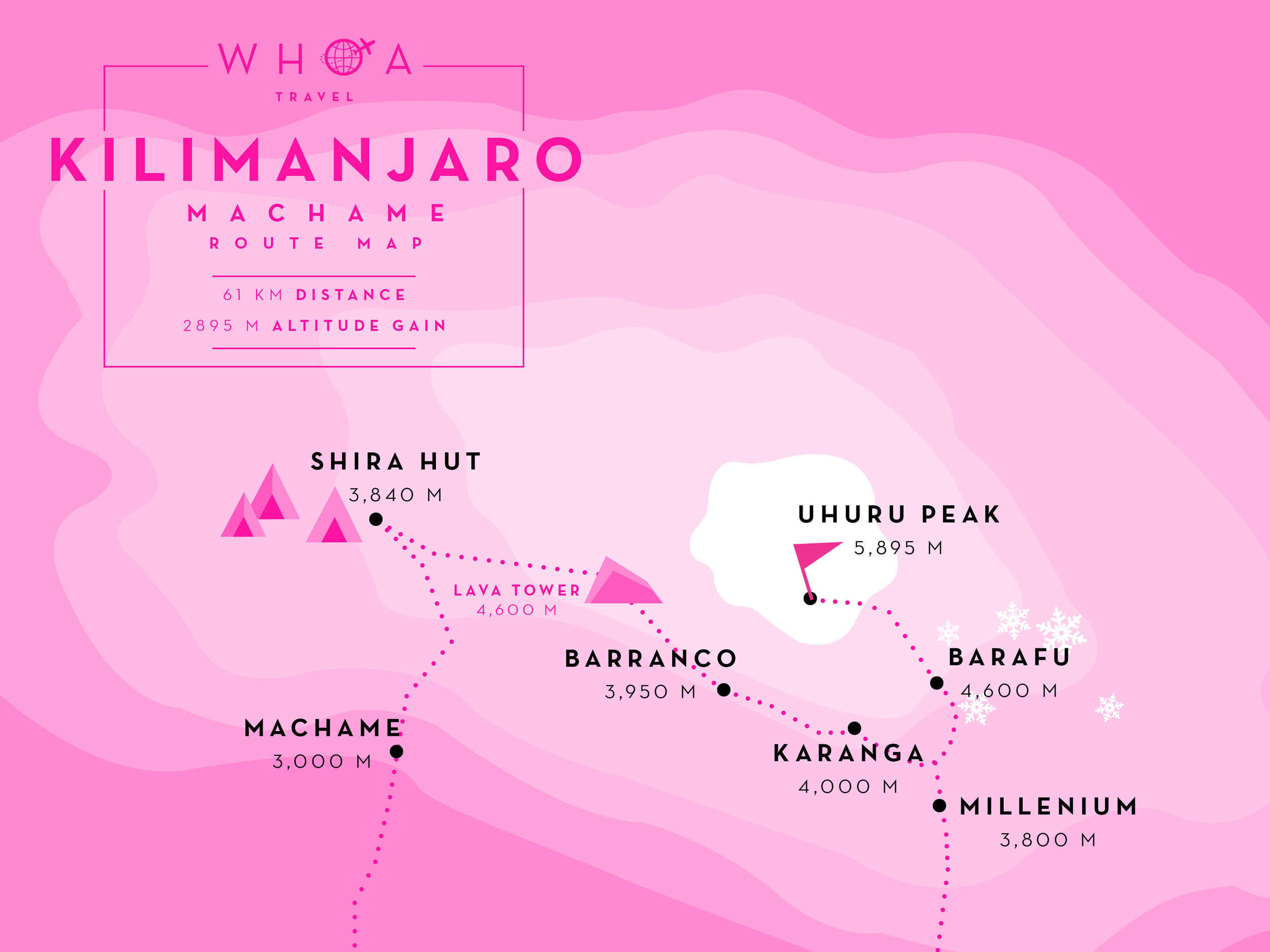KILIMANJARO
ADVENTURE GUIDE
ROUTE MAP
KILIMANJARO FACTS
It’s the tallest free-standing mountain in the world. It's also home to the highest peak in Africa: Uhuru Peak at 5,895 meters.
While classified as a mountain, Kili is actually made up of three volcanic cones. They were formed by the Great Rift Valley, and are called Shira (3,962m), Mawenzi (5,159m), and Kibo (5,895m). While the other two volcanic formations are extinct, some believe Kibo could erupt again one day. The last major eruption was around 360,000 years ago, but some volcanic activity was recorded just 200 years ago.
Despite the strong equatorial sun, there’s a glacier on the top of Kili. It’s brilliant white color is what allows it to survive as it reflects most of the sun’s heat. However, the icecap has shrunk in size by more than 80 percent since 1912, and it’s predicted that it will be gone in 15 years, perhaps sooner.
Once above 4,000 meters, around Karanga Camp on day 4, the temperature drops by 1°C FOR every 150 meters you ascend.
There’s very little light pollution on Kilimanjaro, so the stars of the Southern Hemisphere are vibrant and plentiful. You won’t see the Big Dipper, but you can see the iconic Southern Cross, which is very pronounced thanks the dark nebulae within the Milky Way.
CLIMATE ZONES
ZONE 1:
RAINFOREST
Elevation: 800 - 2,800 m
Avg Temp Range: 32 - 15 °C
Drenched by about six and a half feet of rain each year, the rain forest is lush, green and bursting with life year round. Colobus and Blue monkeys, mongoose and lots of birds and insects can be found amongst the giant ferns, vines, juniper, fig and olive trees. There are lots of endemic flowers for you to look out for too - including violets, orchids and the famous Impatiens Kilimanjari!
ZONE 2:
THE HEATH
Elevation: 2,800 - 3,500 m
Avg Temp Range: 26 - 0 °C
Mist and fog cling to the lower edge of the forest in this zone, but, above the tree line, the land opens out into a clear and cool landscape full of mosses and grasses that are vital for safeguarding the soil and conserving the fleeting moisture. Here you’ll also see everlasting flowers, like Proteas, tall plants with red or yellow tubular blossoms called Red Hot Pokers, and single daisy-like flowers called Helichrysum Meyeri Johannis.
ZONE 3:
MOORLAND
Elevation: 3,500 - 4,000 m
Avg Temp Range: 26 - 0 °C
Sometimes known as the Low Alpine Zone, the air feels crisp and cool here. Shrubs blanket the ground, but still, vegetation is sparse due to the harsher conditions. However, what it lacks in flowers it makes up for in Giant Lobelias and Senecios Kilimanjaris! You’ll see lots of these interesting, stubby palm looking trees that are endemic to the mountain.
ZONE 4:
ALPINE DESERT
Elevation: 4,000 - 5,000 m
Avg Temp Range: 20 - -5 °C
You might feel like you’re on the moon when you’re in the Alpine Desert! There isn’t much life apart from some grasses and a few small flowers. It’s very dusty, dry, and a stunning part of the trek because from here you can see Kilimanjaro’s twin summits, Kibo and Mawenzi. This zone is characterized by bright sun, high evaporation and wide daily changes in temperature.
ZONE 5:
ARCTIC SUMMIT
Elevation: 5,000 - 5,895 m
Avg Temp Range: -5 - -20 °C
The ultimate goal, the uppermost region is a taste of the Arctic just south of the equator! The oxygen level is about half of that at sea level and the sun is fierce. There’s very little wildlife apart from lichens (however, in 1926, a frozen leopard was discovered near the summit crater). On your way to Uhuru Peak from Stella Point you’ll see what remains of the Furtwängler Glacier, an enormous icecap that once crowned the summit.
KILIMANJARO WILDLIFE
COLOBUS MONKEY
These acrobatic monkeys can be seen leaping from tree to tree in the forest canopy of the rain forest, and rarely descend to the ground. They are black with an impressive long “cape” of white hair and a long flowing white tail. These social animals live in groups of three to fifteen members, usually with just one male. In the past, they were hunted by local tribes for their striking black-and-white coats, but their biggest threat today is deforestation.
IMPATIENS KILIMANJARI
These are the most noticeable, brightly colored flowers in the Rain Forest. They blanket damp shady floor there, and are particularly common by streams on the mountain. What the inch-long flowers lack in size, they make up for with their vibrant pinkish-red hood and curved yellow tail. This species grows nowhere else in the world, and truly capture the energy and spirit of the Rain Forest.
WHITE NECKED RAVEN
They are the largest raven species in the region having a wingspan of up to 1 meter wide. They’re known for being tricksters and got their name from the very distinctive white patch on the back of their neck. Their usual diet is insects, seeds and berries, but they’re known for eating pretty much anything. You’ll see lots near the campsites looking for leftover food scraps.
PROTEAS
The floral emblem of South Africa, these everlasting flowers are found in the Heath zone of Kilimanjaro. It’s rare to see them flower. In fact, it’s not a unitary flower, it’s actually a collection of flowers that are densely packed into a bulb that opens up at a certain stage of its maturity. At full maturity the flowers dry and open up appearing to have been burnt by a bush fire.
SCARLET-TUFTED MALACHITE SUNBIRD
These beautiful metallic green birds have a small scarlet patch on either side of their chest. They can often be seen hovering above the grass of the moorlands and hooking their long beaks into the Senecio Kilimanjari to feed on its nectar. These birds are diurnal, meaning active during the day, and are generally seen in pairs or occasionally in small family groups.
SENECIO KILIMANJARI
These crazy looking trees are abundant in the moorland of Kilimanjaro and are found nowhere else in the world! Their woody trunks and crown of large leaves can grow up to 5 m high. On top, they have a long spike of lemon-yellow flowers that bloom about once every 25 years. Their cabbage-like rosettes of tough leaves close at night to protect against frost.
SWAHILI 101
Jambo! Mambo?
Hi! How are you?
POA
good
poa kichizi kama ndizi
crazy cool like a banana
kwaheri!
goodbye!
lala salama
sleep well
tafadhali
please
asante (sana)
thank you (very much)
karibu
you’re welcome
maji ya kunywa
drinking water
maji moto
hot water
twende
let’s go!
pole! pole!
slowly!
pole
sorry
hakuna matata
no worries
dada & kaka
sister & brother
rafiki
friend
Unasemaje...na Kiswahili?
How do you say...in Swahili?
Jina langu ni...
My name is...
Unatoka wapi?
Where are you from?
Ninatoka...
I am from...















